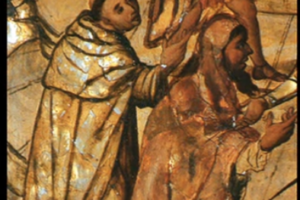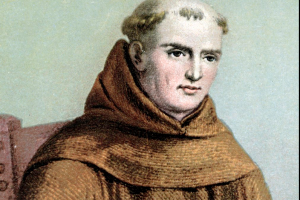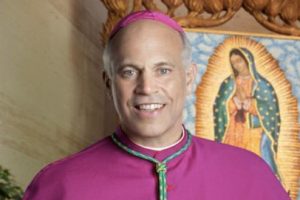In light of the soon-to-begin pilgrimage route from the West, named the Serra Route, that will end in Indianapolis at the National Eucharistic Convention, we re-post this important article on Fr. Serra penned by the Archbishop of San Francisco, Archbishop Salvatore Cordileone:
To the protesters who tore down his statue in Los Angeles [in July 2020], the priest, friar and saint Junípero Serra represents “hate, bigotry and colonization,” as one activist put it. Nothing would have made Serra sadder, for the real man was a profound lover of all people and especially of the indigenous peoples he came to serve.
Seen through the lens of the present, many heroes of history may seem unworthy of their pedestals. But some, such as Serra, still deserve our esteem.Who, then, is Junípero Serra after all?
 First and foremost, Serra represents the true spirit of a church identified with the poor and outcast. He left his home, his family, his sinecure as a philosophy professor to offer the very best thing he had to the California people: the news that God Himself loved them enough to send His only Son to die on a cross to redeem them. Saint Junípero Serra is “the Apostle of California.”
First and foremost, Serra represents the true spirit of a church identified with the poor and outcast. He left his home, his family, his sinecure as a philosophy professor to offer the very best thing he had to the California people: the news that God Himself loved them enough to send His only Son to die on a cross to redeem them. Saint Junípero Serra is “the Apostle of California.”
Serra repeatedly intervened for mercy on behalf of indigenous rebels against Spanish authorities. He famously walked to Mexico City with a painful ulcerated leg to obtain the authority to discipline the military who were abusing the indigenous people. Then he walked back.
And his legacy lives on.
The 21 missions founded by Serra and his brother Franciscans are the state’s oldest structures and among its most visited historic monuments. The churches are a physical sign of the Catholic Church’s respect for local cultures, enriched and transformed by the love of Jesus Christ. Mission architecture is widely copied precisely because its innovation speaks so strikingly to Southwestern culture.
 There is no denying that Native Americans in California endured grave human rights abuses. They suffered wrongs during all three eras: the Spanish colonization (known as the Mission era), the Mexican secularization and the American era. But Serra should not bear the weight of all that went wrong and all who did wrong. If we looked at him with clear eyes, we would see Serra as one of the first American champions of the human rights of indigenous peoples, a man who protested abusive police powers by government authorities.
There is no denying that Native Americans in California endured grave human rights abuses. They suffered wrongs during all three eras: the Spanish colonization (known as the Mission era), the Mexican secularization and the American era. But Serra should not bear the weight of all that went wrong and all who did wrong. If we looked at him with clear eyes, we would see Serra as one of the first American champions of the human rights of indigenous peoples, a man who protested abusive police powers by government authorities.
The deaths that occurred during the Mission era were primarily from disease. The greater, more deliberate devastation happened later, when secular governments took control.
 As UCLA historian Benjamin Madley writes in his book “American Genocide”: “Murders and massacres filled the archives.” As Santa Clara University historian Robert Senkewicz told the National Catholic Reporter, “We do know what did happen when religious groups were not present to try to protect native peoples.” The genocide of native peoples happened primarily during the gold rush, he points out, “when Americans offered bounties for Indian scalps and the native peoples of Northern California were brutally decimated and oppressed.”
As UCLA historian Benjamin Madley writes in his book “American Genocide”: “Murders and massacres filled the archives.” As Santa Clara University historian Robert Senkewicz told the National Catholic Reporter, “We do know what did happen when religious groups were not present to try to protect native peoples.” The genocide of native peoples happened primarily during the gold rush, he points out, “when Americans offered bounties for Indian scalps and the native peoples of Northern California were brutally decimated and oppressed.”
History is often not kind to heroes. George Washington sacrificed to found a great country. He also owned slaves he freed only upon his death. Leland Stanford, founder of a great university, was an abolitionist but also continued genocidal policies against the Indians. Haight-Ashbury, the San Francisco symbol of free love, is named after Henry Haight, who in 1867 called the Chinese a “servile, effeminate and inferior race” that would “pollute and desecrate” Americans’ democratic heritage. He was elected governor of California in a landslide.
We are not yet a nation that lives up to our founding creed of liberty and justice for all. We can and must do better. That is precisely why we ought to look to Serra as an inspiration to heroic virtue and as an emblem of American diversity. His is the path to peace, equality and racial justice. The first Hispanic American saint, he is also the first saint to be canonized on U.S. soil and by the first pope from the Americas. At the canonization ceremony, Pope Francis said Serra represents a fearless willingness to engage with the other with the love of Christ: “He learned how to bring to birth and nurture God’s life in the faces of everyone he met; he made them his brothers and sisters.”
Father Junípero Serra died a beloved figure, mourned by indigenous people and Spaniards alike: a symbol of reconciliation, of hope and of the profound love he bore toward the people he strove to serve. His life reminds us of a core tenet of the Catholic faith: that the spirit of poverty, service and simplicity is the way to peace.
RELATED RESOURCES:
- National Eucharistic Pilgrimage: When is it passing through your town? – Catholic Business Journal
- Terrific First-Hand Account of the Canonization of Saint Junipero Serra, by Fr. Isaiah Teichert, a Camaldolese monk — Catholic Business Journal
- THIS WEEK IN HISTORY: August 30, 1749—St. Junipero Serra sets sail for America – Catholic Business Journal
———————-
Archbishop Salvatore J. Cordileone is the archbishop of the Archdiocese of San Francisco. This Op. Ed. piece first appeared in the Washington Post, June 30, 2020 .



You must be logged in to post a comment.